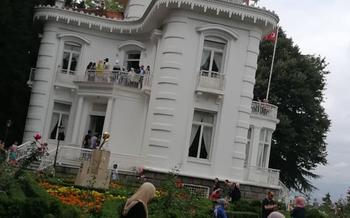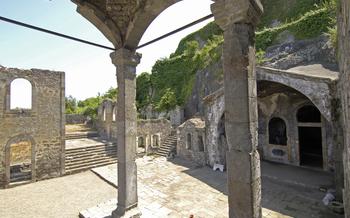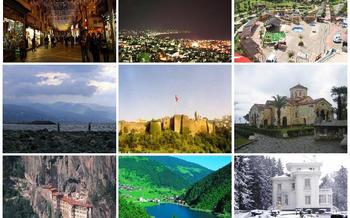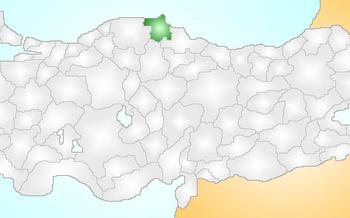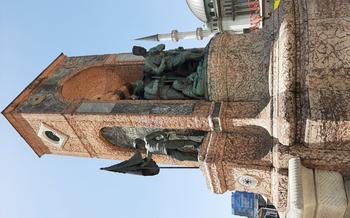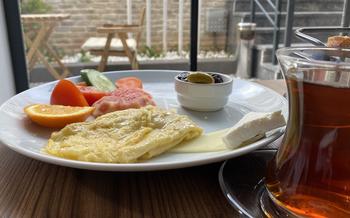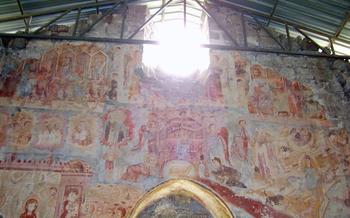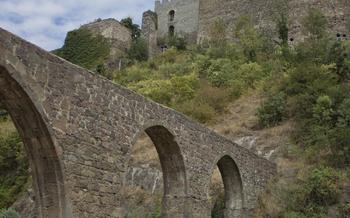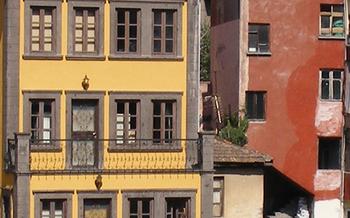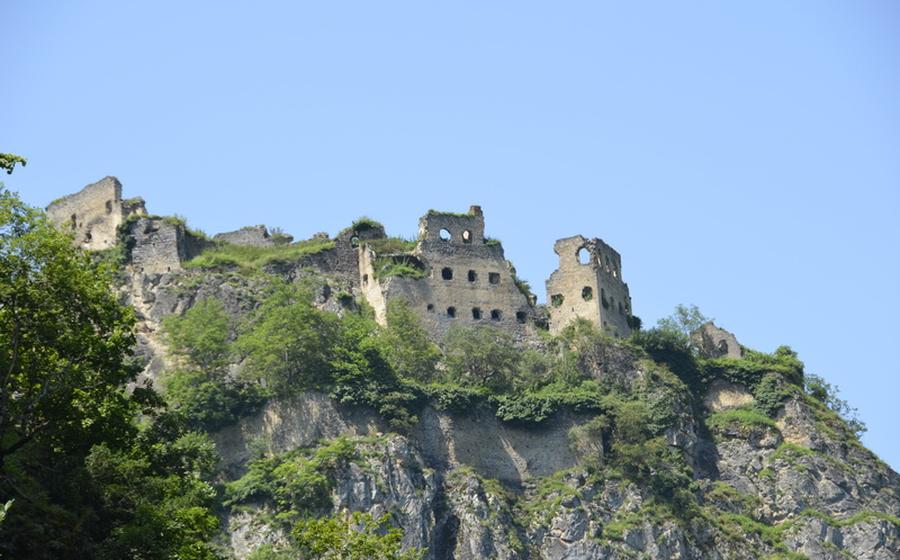
Kuştul Monastery
- Kuştul Monastery: A Journey Through History
- Architectural Marvel
- Interior Beauty
- Monastic Life
- Pilgrimage Site
- Breathtaking Views
- Getting There
- Admission and Fees
- Visiting Hours
- Dress Code and Etiquette
- Guided Tours
- Photography and Videography
- Souvenirs and Shopping
- Nearby Attractions
- Insider Tip: Unveiling the Secret Chamber
Kuştul Monastery: A Journey Through History
The Kuştul Monastery, nestled in the picturesque hills of Trabzon, Turkey, stands as a testament to centuries of religious devotion and architectural brilliance. Founded in the 10th century by Georgian monks, this Eastern Orthodox monastery has witnessed the rise and fall of empires, the ebb and flow of religious influences, and the enduring spirit of faith.
Throughout the centuries, the Kuştul Monastery served as a spiritual haven for monks and pilgrims alike, its sacred halls echoing with prayers and the tranquil melodies of Byzantine chants. Despite political and religious upheavals, the monastery miraculously survived, preserving its architectural integrity and religious significance.
Today, the Kuştul Monastery remains a living testament to the enduring power of faith and the resilience of human spirit. Its rich history, captivating architecture, and spiritual ambiance continue to draw visitors from around the world, offering them a glimpse into the depths of Orthodox Christianity and the enduring legacy of the past.
Architectural Marvel
The Kuştul Monastery stands as a testament to the fusion of Byzantine and Georgian architectural styles. Its unique design features a cruciform layout, with a central dome supported by four massive pillars. The exterior walls are adorned with intricate stone carvings depicting religious scenes and geometric patterns. The monastery's windows are narrow and arched, allowing for ample natural light to illuminate the interior while maintaining a sense of privacy and seclusion.
The domes, a signature feature of Byzantine architecture, add a sense of grandeur and majesty to the monastery's appearance. The largest dome, positioned over the crossing of the transept and nave, symbolizes the heavens and the divine presence. Smaller domes adorn the corners of the building, creating a dynamic and visually appealing silhouette.
The stone carvings that embellish the monastery's facade and interior are exquisite examples of medieval craftsmanship. These intricate carvings depict biblical scenes, saints, and mythical creatures, adding a layer of symbolism and narrative to the monastery's architecture. They serve as a visual representation of the rich religious and cultural heritage of the region.
The harmonious blend of Byzantine and Georgian architectural elements in the Kuştul Monastery showcases the region's diverse artistic influences. Its unique design features, from the cruciform layout to the elaborate stone carvings, make it an architectural masterpiece that continues to inspire and captivate visitors to this day.
Interior Beauty
Step inside the Kuştul Monastery, and you'll be greeted by a breathtaking display of Byzantine and Georgian artistry. The walls are adorned with vibrant frescoes and mosaics that depict religious scenes and stories from the Bible. Each artwork is a masterpiece in its own right, showcasing intricate details, vibrant colors, and profound religious symbolism.
The monastery's main church, known as the Church of the Dormition, is particularly awe-inspiring. Its interior is a symphony of colors and shapes, with frescoes covering every inch of the walls and ceiling. These paintings tell the story of the life of Christ, from his birth to his crucifixion and resurrection. The vibrant hues of blue, gold, and red create a sense of heavenly grandeur, transporting visitors to another time and place.
In addition to the frescoes, the monastery also boasts a collection of stunning mosaics. These intricate works of art depict various saints, martyrs, and biblical figures. Each mosaic is a testament to the skill and devotion of the artisans who created them.
The interior of the Kuştul Monastery is not just a visual feast but also a spiritual sanctuary. The atmosphere is serene and contemplative, inviting visitors to reflect on their faith and connect with the divine. Whether you're a devout Orthodox Christian or simply an admirer of art and history, the interior of the Kuştul Monastery is sure to leave a lasting impression.
Monastic Life
The Kuştul Monastery was a vibrant center of monastic life for centuries. The monks who resided within its walls dedicated their lives to prayer, contemplation, and service. They followed a strict daily routine that revolved around religious rituals, prayers, and work. The monastery provided them with a communal space where they could live in harmony and devotion, away from the distractions of the outside world.
The monks played a crucial role in preserving the spiritual and cultural heritage of the region. They were responsible for copying and illuminating manuscripts, translating religious texts, and teaching theology to future generations. They also provided spiritual guidance and counseling to the local community, offering solace and support in times of need.
The monastic community of the Kuştul Monastery was a close-knit one, bound by shared beliefs and a common purpose. They worked together to maintain the monastery, cultivate the surrounding land, and provide for their needs. Their daily lives were marked by a sense of simplicity, humility, and devotion, as they sought to live in accordance with the teachings of Jesus Christ.
Pilgrimage Site
The Kuştul Monastery holds a significant place as a pilgrimage site for Orthodox Christians. Devout believers from near and far embark on pilgrimages to seek spiritual solace and pay homage to the holy relics and icons housed within the monastery's sacred walls. The monastery's reputation as a spiritual sanctuary attracts thousands of pilgrims annually, especially during religious festivals and celebrations. These festivals, steeped in tradition and reverence, showcase the rich cultural heritage of the Orthodox faith. Pilgrims gather to participate in solemn ceremonies, offer prayers, and receive blessings, creating a deeply moving and communal experience. The monastery's holy relics, believed to possess miraculous powers, draw pilgrims seeking divine intervention and healing. The atmosphere during these religious gatherings is palpable, as pilgrims immerse themselves in the spiritual energy that permeates the monastery grounds, finding solace, hope, and a renewed sense of faith.
Breathtaking Views
The Kuştul Monastery boasts breathtaking panoramic views that are sure to leave visitors in awe. Perched atop a hill overlooking the Black Sea and nestled amidst the lush greenery of the surrounding mountains, the monastery offers a truly unforgettable visual experience. From the monastery's terraces and windows, visitors can feast their eyes on the vast expanse of the Black Sea, stretching as far as the horizon. The deep blue waters, dotted with sailboats and fishing vessels, create a mesmerizing contrast to the verdant landscapes that envelop the monastery. The surrounding mountains, with their majestic peaks and rolling hills, add a dramatic backdrop to the scene. Watching the sun setting over the Black Sea from the monastery's vantage point is an experience that will linger in the memory long after the visit. The sky transforms into a canvas of fiery hues, casting a warm glow on the surrounding landscape, creating a moment of sheer tranquility and awe.
Getting There
Reaching the Kuştul Monastery from Trabzon involves a scenic journey through the picturesque landscapes of the Black Sea region. The monastery is located approximately 45 kilometers southeast of Trabzon city, offering a tranquil escape from the urban hustle and bustle. To get there, visitors can opt for public transportation, taxis, or rental cars, depending on their preference and budget. Public buses depart regularly from the Trabzon Otogar (bus station) and take around 1 hour and 30 minutes to reach the monastery. Alternatively, taxis provide a more convenient option, with a journey time of approximately 1 hour. For those seeking flexibility and independence, renting a car allows for a self-paced exploration of the region, with the drive taking around 1 hour and 15 minutes. Upon arrival, visitors will be greeted by the monastery's stunning façade, nestled amidst lush greenery and offering a glimpse into its rich history and spiritual significance.
Admission and Fees
Visiting the Kuştul Monastery does not require an entrance fee or any admission charges. It is free and open to the public, welcoming all visitors regardless of their religious affiliation or background. This open-door policy allows everyone to experience the monastery's historical, architectural, and spiritual significance without financial barriers. However, donations are gratefully accepted to support the ongoing preservation and maintenance of this sacred site. Visitors can contribute voluntarily to help ensure the monastery's legacy continues to inspire and enrich future generations.
Visiting Hours
The Kuştul Monastery welcomes visitors during specific operating hours and days of the week. It is essential to plan your visit accordingly to avoid disappointment. The monastery typically opens its doors from 9:00 AM to 5:00 PM, seven days a week. However, it is advisable to check the monastery's official website or contact local authorities for any temporary changes or special closures during holidays or events.
Advance reservations or bookings are generally not required for individual visitors. However, if you are traveling in a large group or have special requests, it is recommended to contact the monastery in advance to ensure a smooth and seamless visit.
Visiting the Kuştul Monastery during the early morning or late afternoon hours is ideal to avoid crowds and experience the tranquility of the site. The monastery's serene atmosphere and breathtaking views are best enjoyed when there are fewer visitors, allowing you to fully immerse yourself in its spiritual and historical significance.
Dress Code and Etiquette
When visiting the Kuştul Monastery, it is important to observe proper dress code and etiquette out of respect for the religious and cultural significance of the site. Visitors should avoid wearing revealing or excessively casual clothing. Instead, opt for modest attire that covers the shoulders and knees. Shorts, tank tops, and flip-flops are generally not appropriate.
It is also important to be mindful of noise levels and refrain from loud talking or disruptive behavior. Photography and videography are permitted, but visitors should be respectful of the privacy of other visitors and avoid using flash or tripods inside the monastery.
By following these guidelines, visitors can contribute to preserving the sacred atmosphere of the Kuştul Monastery and ensure a peaceful and enjoyable experience for all.
Guided Tours
Guided tours of the Kuştul Monastery offer an enriching and informative experience for visitors. Knowledgeable guides provide insights into the monastery's history, architectural wonders, and religious significance, bringing the ancient walls to life. Tours are available in various languages, ensuring that visitors from different backgrounds can delve into the monastery's rich heritage. Specialized tours focusing on specific aspects, such as Byzantine art or monastic traditions, may also be offered. Whether you're a history buff, an architecture enthusiast, or a spiritual seeker, a guided tour will enhance your understanding and appreciation of the Kuştul Monastery.
Photography and Videography
The Kuştul Monastery welcomes visitors to capture the beauty and spirituality of the site through photography and videography. However, it is important to respect the privacy of other visitors and maintain the solemnity of the monastery. Flash photography is discouraged to preserve the integrity of the artwork and avoid disturbing the tranquil atmosphere. Visitors are encouraged to be mindful of their surroundings and avoid causing any disruption to religious ceremonies or services. By adhering to these guidelines, visitors can create lasting memories of their visit while respecting the sacredness of the monastery.
Souvenirs and Shopping
While visiting the Kuştul Monastery, visitors can take home a piece of its history and significance through the monastery's gift shop. This shop offers a variety of souvenirs and religious items that are both meaningful and unique. Visitors can purchase icons depicting saints and scenes from the Bible, as well as candles, prayer books, and other religious items. These items serve as a reminder of the monastery's spiritual significance and allow visitors to continue their spiritual journey at home.
One of the most popular souvenirs from the monastery is the handmade pottery. These ceramics are crafted by local artisans using traditional techniques passed down through generations. Each piece is unique and reflects the artistic heritage of the region. Visitors can choose from a variety of pottery items, including plates, bowls, vases, and decorative figurines, each adorned with intricate designs and vibrant colors.
Nearby Attractions
The Kuştul Monastery is surrounded by several other notable attractions that visitors can explore. Just a short distance away lies the stunning Uzungöl, a picturesque lake nestled amidst lush forests and towering mountains. Visitors can enjoy a peaceful boat ride on the lake, admire the breathtaking views, and immerse themselves in the tranquility of nature.
For those interested in history and culture, the Trabzon Museum is a must-visit. Located in the heart of the city, the museum houses a vast collection of artifacts, including ancient coins, pottery, manuscripts, and ethnographic objects. Visitors can learn about the rich history and diverse cultures of the Trabzon region and gain a deeper understanding of its past.
Nature enthusiasts will delight in exploring the Sera Lake National Park, home to a diverse array of flora and fauna. Visitors can hike through the park's pristine forests, spot rare bird species, and admire the stunning views of the Sera Lake and the surrounding mountains. The park offers a refreshing escape from the hustle and bustle of the city and a chance to reconnect with nature.
For a unique cultural experience, visitors can head to the Atatürk Köşkü, a historic mansion that once served as the summer residence of Mustafa Kemal Atatürk, the founder of the Turkish Republic. The mansion has been converted into a museum and offers insights into Atatürk's life and the early days of the Turkish Republic.
These nearby attractions complement the experience of visiting the Kuştul Monastery and provide a well-rounded itinerary for exploring the diverse offerings of the Trabzon region.
Insider Tip: Unveiling the Secret Chamber
Beyond the main attractions of the Kuştul Monastery, there lies a hidden gem that few visitors know about—a secret chamber tucked away within the monastery walls. This chamber, once used for storing precious religious artifacts and manuscripts, has been preserved in its original state, offering a glimpse into the monastery's rich past. To access this hidden treasure, ask a monk or guide to lead you to the chamber. As you step inside, you'll be transported back in time, surrounded by centuries-old relics and the echoes of history. Discover the secrets of this sacred space and gain a deeper understanding of the monastery's enduring legacy.
